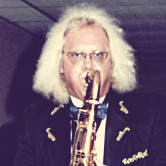For me, the high F”# key was a rarity, a mythical creature that I did not see until my college years. I thought it entirely useless… after all, like everyone said, they don’t write higher than the high F for the Saxophone, anyway.
Well, I was wrong, they were wrong, and the music store owners who talked me out of ordering the high F# option were wrong. I now find this key to be a very useful, welcome addition to the Saxophone.
Dave wrote:
I am still getting used to the feel of this horn and I never had a high F# key to use before. I really should get hold of a modern fingering chart for these things.
Thanks, Dave
Paul answers:
Dave, there are so many good uses for the high F# key, besides the obvious one. But let me first mention this… to use the various fingerings I will show you, you must get in the habit of using the right hand middle finger to press the high F# key.
The first and most obvious use of the high F# key is to extend the range of the regular palm key fingerings. So, for the “palm key high F#” you would press the D, Eb, and F palm keys with the left hand, the high E key with the knuckle of the right hand, and with the middle finger of the right hand, the high F# key. Of course you know the “fork E and fork F”. These use the “front F key”, also called variously the “fork F key”, “auxiliary F key”, or “alternate F key”. The E3 can also be fingered: Octave key, front F key, LH2, LH3. This works on soprano, alto, and tenor saxophones. For bari sax, and some tenors, you must add the RH2 to bring this note in tune. Practice playing from C3 (Octave Key and LH2) to the fork E fingering, and back to C3. Also practice playing from D3 (Octave key and D palm key) to the fork E and back to D3.
F3 may also be played with the fork F fingering, which is: Octave Key, front F key, LH2. Practice playing from C3 to F3 and back. Incorporate the fork E and F fingerings into your playing as much as possible. So, to extend this even further, you may use the high F# key with the fork F fingering to produce another high F# (F#3). I call this the “fork F#.” Or, you may simply add the high F# key to the A2 fingering (Octave Key, LH1, LH2) and you have another easy, fast high F#. The high F# key can be used to produce an excellent high G (G3).
For alto and soprano, this is fingered: Octave Key, front F key, RH1, high F# key. It is easily seen that it is very easy to go to this high G from fork E, fork F, or fork F#. This G3 is hereby named “fork G”.
For tenor sax, the fingering is slightly different. To play G3 on the tenor: Octave Key, LH1, side Bb key, high F# key. This is the clearest, most stable high G that can be played on the tenor saxophone. And it is not flat, as is the traditional fingering.
So, here are a number of fingerings that utilize the high F# key. I hope they help your high register playing as much as they do for me.
Dave wrote back:
Far more ways to use the high F# key than I imagined. I will have to train myself to use the second finger to add the high F# key quickly and accurately.


